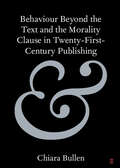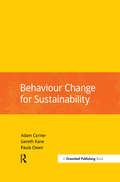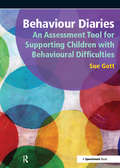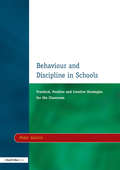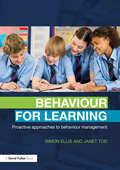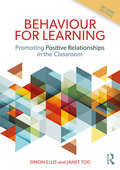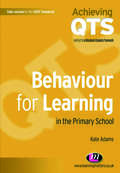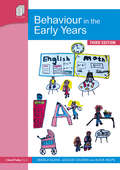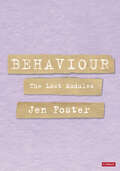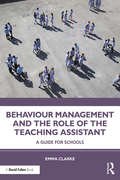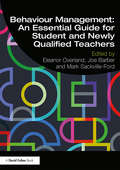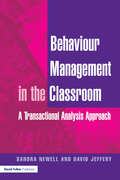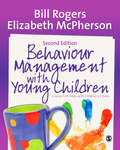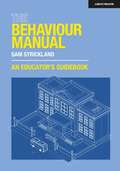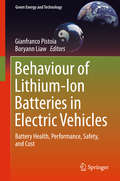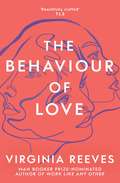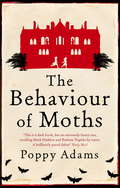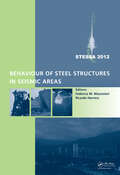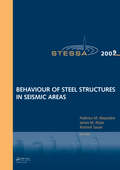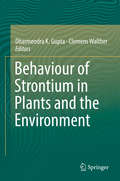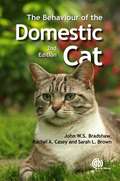- Table View
- List View
Behaviour Beyond the Text and the Morality Clause in Twenty-First-Century Publishing (Elements in Publishing and Book Culture)
by Chiara BullenA morality clause allows contracting parties to terminate a contractual agreement with those who exhibit behaviour deemed unacceptable. Established in 1920s Hollywood, these contractual clauses are now found in twenty-first-century publishing agreements. This Element investigates the presence of the morality clause in the UK book publishing industry in relation to an increased focus on author behaviour beyond the text in the twenty-first-century, examining the way it operates within the publishing field in the context of behaviour perceived to be 'problematic'. It asserts the clause is perceived to be needed due to the emergence of social media and twenty-first-century social contexts combining to impact the author-reader relationship which, in turn, leads to author behaviour acting as a paratextual threshold to their work. This Element presents an analysis of the morality clause in practice, concluding the clause has the potential to further the power imbalance between author and publisher.
Behaviour Change for Sustainability
by Adam Corner Gareth Kane Paula OwenBehaviour Change for Sustainability is a compilation of 3 bestselling sustainability guides that gathers together, in one place, a variety of effective tools and techniques for encouraging a lasting shift to sustainable behaviours in business and society. Promoting Sustainable Behaviour offers the definitive guide to building a sustainable behaviour campaign that works. By summarising "what really works" and pulling out the most important messages from the evidence base, this book contains all the tools you need to maximize the success of your sustainable behaviour initiative – in households, when commuting, in the workplace and beyond. Green Jujitsu outlines the smart way to embed sustainability within the culture of any organization, by working with employees' strengths and interests. Gareth Kane points out the hallmarks of unsuccessful approaches to cultural change, which are often confused, unimaginative or confrontational. He puts forward an alternative framework designed to play to people's strengths and interests and genuinely engage them in problem-solving. Gamification is fast emerging as a user engagement and behaviour change tool that succeeds where other tactics and strategies have failed. How Gamification Can Help Your Business Engage in Sustainability contains all the information businesses and other organizations need to make an informed decision about whether to adopt gamification as part of their own business and sustainability strategies – and the tools to get started.
Behaviour Diaries: An Assessment Tool for Supporting Children with Behavioural Difficulties
by Sue GottThe invaluable resource provides a sophisticated technique for teachers to observe, assess, plan and evaluate to improve pupil behaviour. The book recognises the diverse demands of the modern classroom and explores ways in which asking the right question can help in the development of effective solutions. This is far more than ticking check lists as it will: develop a more rigorous approach to the tracking and assessment of behaviour related issues; deepen understanding about biological, psychological and social factors influencing behaviour; give examples of reflective and diagnostic practice, informing planning for successful interventions; and explore ways of collecting appropriate information to support requests for interventions from other agencies. The pack includes a CD ROM with reflective tasks, diagnostic tools, illustrative poems and a staff Powerpoint for professional development sessions.
Behaviour & Discipline in Schools, Two: Practical, Positive & Creative Strategies for the Class (Behavior And Discipline In Schools Ser. #Vol. 2)
by Peter GalvinFirst Published in 1999. Routledge is an imprint of Taylor & Francis, an informa company.
Behaviour for Learning: Proactive Approaches to Behaviour Management
by Simon Ellis Janet TodBehaviour for Learning offers teachers a clear conceptual framework for making sense of the many behaviour management strategies on offer, allowing them to make a critical assessment about their appropriateness and effectiveness in the classroom. Teachers need to be asking themselves the question "How can I improve a child’s learning?" rather than "How can I get them to behave?" The authors present a unique focus on the relationships which underpin learning, placing an emphasis on the development of ‘learning behaviours’, and endorses OFSTED’s view that it is essential to evaluate the efficacy of behaviour management against progress in learning. Essentially, this book will help teachers: decide what strategy is best for individuals in their classroom be aware of the evidence / theoretical base that underpins that strategy use be able to evaluate the effectiveness of that strategy. Located within emerging agendas for improved individual holistic outcomes and increased partnership working, this book seeks to synthesise the practical with the theoretical. Authoritative and timely, Behaviour for Learning is compelling reading for all trainees and practicing teachers, CPD coordinators and other professionals working with challenging pupils.
Behaviour for Learning: Promoting Positive Relationships in the Classroom
by Simon Ellis Janet TodBehaviour for Learning offers teachers a clear conceptual framework for making sense of the many behaviour management strategies on offer, allowing them to make a critical assessment of their appropriateness and effectiveness in the classroom, and assisting them to promote closer links between ‘behaviour’ and ‘learning’. Now in a fully updated second edition, the book focuses on how teachers can provide a safe and secure setting where positive relationships are fostered, placing increased emphasis on learning behaviours that contribute to pupils’ cognitive, social and emotional development. The book is full of practical approaches that can help teachers support pupils to achieve, relate to others and develop behaviours that characterise self-esteem, confidence and resilience. It includes chapters covering: • relationship with the curriculum, relationship with self and relationship with others; • whole-school approaches and the school behaviour policy; • reframing special educational needs; • dealing with more challenging behaviour; • transitions. This second edition also includes an updated emphasis on the links between mental health, behaviour and relationships in schools, and reflects Department for Education advice for school staff, changes to the National Curriculum and the new SEND Code of Practice. Through the application of the Behaviour for Learning framework, the book encourages teachers to address the needs of pupils who exhibit behavioural difficulties, whilst still pursuing excellence in teaching and learning for all pupils. It is a compelling and essential read for all trainees and practising teachers, CPD coordinators and other professionals working with children in schools.
Behaviour for Learning in the Primary School (Achieving QTS Series)
by Kate AdamsChildren′s behaviour is a key concern for trainees and teachers. This book explores the concept of behaviour for learning which is very much driven by the Every Child Matters agenda. It examines the roles of relationships and children′s social knowledge in depth. In particular, it explores relationship with self, relationship with others and relationships with the curriculum. It also considers the importance of self-reflection and other additional factors affecting behaviour for learning such as children′s learning difficulties. It highlights the complexities and wider social factors involved in attaining positive behaviour, in a way which recognises the whole child.
Behaviour in the Early Years: Behaviour In The Early Years (Tried And Tested Strategies Ser.)
by Angela Glenn Jacquie Cousins Alicia HelpsThis accessible and practical book provides hands-on, tried and tested strategies to help the reader respond instantly and effectively to behaviour problems in early years settings. It encourages the practitioner to think about how they handle difficult situations and to understand why children behave as they do. Including topics on the development of the child from birth to toddler, managing the environment, and safeguarding children, this third edition has also been fully updated to include: guidance on complex learning difficulties, including autism and speech and language disorders; exploration of the use and impact of social media, technology and digital devices on social interaction; managing and facilitating the transition from an early years setting to school; an outline of the Education and Health Care Plan, including request and implementation. Other features include a vast number of case studies, social and developmental checklists, a glossary and useful addresses. With ideas and strategies that can easily be absorbed into the daily routine, this book is essential reading for practitioners in all early years settings looking for effective ways to deal with challenging behaviour.
Behaviour: The Lost Modules
by Jen FosterOh hey! Thank you for being here. Let me introduce myself. My name is Jen Foster and I am an educator. A few years ago, I started an Instagram account dedicated to teaching. I started by just sharing everything and anything and loving having a community of keen beans like me. But it didn′t take me long to spot something quite odd. Scrolling through thousands of teachers′ experiences around the world there were two things that stood out like a sore thumb: Behaviour was this huge obstacle in teaching;The guidance around behaviour was either inconsistent, vague or unhelpful. So, I decided to learn everything I could about behaviour. I explored outside the education shelves and bought way too many books about neuroscience, positive psychology, business, and parenting. The more I learnt, the more I reflected on my own practice and my own experiences in schools. I asked educators in my community their opinions on behaviour, and this is what I found out: 93% felt that they had inadequate behaviour training as a trainee teacher 88% feel they have inadequate behaviour training as a qualified teacher So, isn′t it about time we shined a spotlight on behaviour? Behaviour: The lost Modules is the book you wish you had read before stepping into a classroom. The book you wish had been required reading on your university reading list. A book that is practical, easy to read and tells you what you need to know about behaviour in primary schools. A book by a teacher for teachers, drawing on common sense, personal experiences and current research.
Behaviour: The Lost Modules
by Jen FosterOh hey! Thank you for being here. Let me introduce myself. My name is Jen Foster and I am an educator. A few years ago, I started an Instagram account dedicated to teaching. I started by just sharing everything and anything and loving having a community of keen beans like me. But it didn′t take me long to spot something quite odd. Scrolling through thousands of teachers′ experiences around the world there were two things that stood out like a sore thumb: Behaviour was this huge obstacle in teaching;The guidance around behaviour was either inconsistent, vague or unhelpful. So, I decided to learn everything I could about behaviour. I explored outside the education shelves and bought way too many books about neuroscience, positive psychology, business, and parenting. The more I learnt, the more I reflected on my own practice and my own experiences in schools. I asked educators in my community their opinions on behaviour, and this is what I found out: 93% felt that they had inadequate behaviour training as a trainee teacher 88% feel they have inadequate behaviour training as a qualified teacher So, isn′t it about time we shined a spotlight on behaviour? Behaviour: The lost Modules is the book you wish you had read before stepping into a classroom. The book you wish had been required reading on your university reading list. A book that is practical, easy to read and tells you what you need to know about behaviour in primary schools. A book by a teacher for teachers, drawing on common sense, personal experiences and current research.
Behaviour Management and the Role of the Teaching Assistant: A Guide for Schools
by Emma ClarkeBehaviour Management and the Role of the Teaching Assistant draws on the latest research as well as teaching assistants' own views to enable readers to reconsider TA deployment and to maximise the benefits TAs have to offer in supporting children’s behaviour. It considers the difficulties facing TAs, summarises the key stages in the evolution of their role in the classroom and highlights the significant challenges of TAs’ role definition. Using current research findings, this book provides guidance and practical activities to support schools in empowering TAs to work with children whose behaviour challenges. Each chapter considers a range of strategies for working with TAs, as well as the strengths and limitations of these approaches. There are also a range of self-/school-auditing and self-evaluation tasks with key points to consider and practical in-school suggestions at the end of each chapter. This is essential reading for professionals at all levels working in schools wanting to understand how teaching assistants can best be supported to successfully manage behaviour in schools.
Behaviour Management: An Essential Guide for Student and Newly Qualified Teachers
by Eleanor Overland Joe Barber Mark Sackville-FordBehaviour Management: An Essential Guide for Student and Newly Qualified Teachers explores the current issues and theories in behaviour management. It encourages readers to think and reflect on their own experiences and offers practical advice for developing confidence in the classroom and quickly adapting to the changing needs of different students and settings. Each chapter of the book focuses on a different aspect of behaviour management, addressing issues such as building routines, health and safety, mental health and using technology to support behaviour management. It includes: Tasks designed to encourage analytical, reflective and original thinking. Resources and guidance to develop practice and collate evidence to add to portfolios or other files required by tutors, mentors and assessors. Case studies from personal experience that provide tips and tools for effectively managing behaviour. This book is an essential resource for student teachers, newly or recently qualified teachers and anyone with an interest in developing an understanding of behaviour within schools.
Behaviour Management: Getting it Right in a Week (Getting it Right in a Week)
by Susan WallaceIs the behaviour of some of your learners a concern for you? Do you want to address low-level disruption in your classroom? Have you developed medium- to long-term strategies to motivate your learners? This book is a response to the number one concern of teachers - behaviour management. It offers you a straightforward toolkit of strategies and approaches with examples of how they might be applied in practice. It is short and to the point. It doesn't make you wade through a lot of theory but points you to where you can find out more about the thinking behind the strategies. Designed to be read over a week, the book is divided into seven concise chapters to help you build positive relationships and a productive classroom environment.
Behaviour Management in the Classroom: A Transactional Analysis Approach
by David Jeffery Sandra NewellAsk any trainee teacher, or indeed experienced teacher, which aspect of teaching concerns them most and they will probably say "getting pupils to behave." This book looks at the relationships between teachers and pupils in the classroom. It explores ways of using the ideas in Transactional Analysis to create win-win situations in the classroom, making a more pleasant and productive atmosphere for all concerned. It offers teachers practical examples of how to model behavior, structure time, use contracts and praise pupils in order to avoid or resolve conflict quickly and fairly so that everyone feels OK and learning is put at the forefront. The authors both have extensive experience of teaching and managing behavior and have much to offer in terms of guidance for managing your classes successfully. The book provides a simple introduction to and explanations of aspects of the theory; lots of practical examples, strategies and suggestions; reflections and activities; and bullet-pointed summaries at the end of each chapter.
Behaviour Management with Young Children: Crucial First Steps with Children 3–7 Years
by Elizabeth Mcpherson Dr Bill Rogers'This book will make a difference not only to the behaviour of pupils but also to the sanity of teachers.' -Jane Bellamy, Headteacher, Wold Newton School, Wold Newton, Driffield, East Riding of Yorkshire 'It is what we have been waiting for. A delight to read and will be a constant source of inspiration and guidance to us all.' -Cathy Whalen, Headteacher, Mousehold Infant and Nursery School, Norwich, Norfolk 'What a privilege to read a book written by the person that has had the most impact on my classroom teaching and the whole ethos of our school.' -Debbie Hoy, Headteacher, Brookland Infant & Nursery School, Cheshunt, Hertfordshire Written by Behaviour Management expert, Bill Rogers and his daughter and Early Years teacher, Elizabeth McPherson, this book explores behaviour management in the crucial early years. Essential skills are explored in detail through a wide range of case studies and with specific focus on: challenging student behaviour positive discipline practice students with special behaviour needs how colleague support can help our day-to-day teaching anger management and safe restraint how to set up and maintain a whole-class behaviour agreement. The ultimate guide for early years students, educators and teachers, this book will change the way you think and practice. Bill Rogers is an Independent Educational Consultant based in Australia. Elizabeth McPherson is an Early Years Teacher in Australia.
Behaviour Management with Young Children
by Bill Rogers Elizabeth McphersonWritten by Behaviour Management expert, Bill Rogers and his daughter, Early Years teacher, Elizabeth MacPherson, this will be an essential book for all Early Years students, infant teachers, support staff and school leaders. This book explores behaviour management in the crucial early years of schooling in an accessible and practical way. The authors emphasise the establishment phase of a teacher's relationship with a new class. The essential skills are explored in detail through a wide range of case studies. The authors cover all the major topics such as: - challenging student behaviour - positive discipline practice - behaviour recovery practice - helping students with special behaviour needs - how colleague support can help our day-to-day teaching - how to set up and maintain a whole-class behaviour agreement.
The Behaviour Manual: An Educator's Guidebook
by Samuel StricklandThe Behaviour Manual – An Educator's Guidebook offers over 100 strategies, approaches and teaching methods that will help any school, leader, middle leader, teacher, ECT or ITT to pro-actively lead on behaviour. It has been designed to help the entire profession and anyone at any level and all ranges of experience. The book is divided into three broad sections. Section one examines the role of the Mothership (the school) and the role that leaders at any level can play. Section two looks at the role of the Satellites (the key areas that make up the school) and the integral role that middle leaders play. The final section looks at the micro level, focusing on the role that teachers play and offers a plethora of approaches teachers can employ. Each of the 100+ strategies is unpacked over a one or two-page spread. Within each spread is an outline of what the approach is, it is then unpacked to detail how it works or can be applied and each spread finishes with a cautionary warning and an advice tip. This book is deliberately written to help, to offer support, to offer advice and there is, bluntly, no waffle, no padding and no fluff.If you want a book that you can pick up, easily read and digest a key approach or strategy in less than 5-10 minutes then this is for you. It is grounded in expertise, experience, research and deliberately written in a clear, straightforward and open style that leaves you in no doubt regarding how any of the given approaches works and could be employed in your school setting.
The Behaviour Manual: An Educator's Guidebook
by Samuel StricklandThe Behaviour Manual – An Educator's Guidebook offers over 100 strategies, approaches and teaching methods that will help any school, leader, middle leader, teacher, ECT or ITT to pro-actively lead on behaviour. It has been designed to help the entire profession and anyone at any level and all ranges of experience. The book is divided into three broad sections. Section one examines the role of the Mothership (the school) and the role that leaders at any level can play. Section two looks at the role of the Satellites (the key areas that make up the school) and the integral role that middle leaders play. The final section looks at the micro level, focusing on the role that teachers play and offers a plethora of approaches teachers can employ. Each of the 100+ strategies is unpacked over a one or two-page spread. Within each spread is an outline of what the approach is, it is then unpacked to detail how it works or can be applied and each spread finishes with a cautionary warning and an advice tip. This book is deliberately written to help, to offer support, to offer advice and there is, bluntly, no waffle, no padding and no fluff.If you want a book that you can pick up, easily read and digest a key approach or strategy in less than 5-10 minutes then this is for you. It is grounded in expertise, experience, research and deliberately written in a clear, straightforward and open style that leaves you in no doubt regarding how any of the given approaches works and could be employed in your school setting.
Behaviour of Lithium-Ion Batteries in Electric Vehicles
by Gianfranco Pistoia Boryann LiawThis book surveys state-of-the-art research on and developments in lithium-ion batteries for hybrid and electric vehicles. It summarizes their features in terms of performance, cost, service life, management, charging facilities, and safety. Vehicle electrification is now commonly accepted as a means of reducing fossil-fuels consumption and air pollution. At present, every electric vehicle on the road is powered by a lithium-ion battery.Currently, batteries based on lithium-ion technology are ranked first in terms of performance, reliability and safety. Though other systems, e.g., metal-air, lithium-sulphur, solid state, and aluminium-ion, are now being investigated, the lithium-ion system is likely to dominate for at least the next decade – which is why several manufacturers, e.g., Toyota, Nissan and Tesla, are chiefly focusing on this technology.Providing comprehensive information on lithium-ion batteries, the book includes contributions by the world’s leading experts on Li-ion batteries and vehicles.
The Behaviour of Love: A Novel
by Virginia ReevesFrom 2016 Man Booker longlisted Virginia Reeves comes a moving and riveting new novel about the head doctor of a mental institution whose marriage and job come under threat when he and a younger patient develop a relationship. Doctor Ed Malinowski believes he has realized most of his dreams. A passionate, ambitious behavioural psychologist, he is now the superintendent of a mental institution and finally turning the previously crumbling hospital around. He also has a home he can be proud of, and a fiercely independent, artistic wife Laura, whom he hopes will soon be pregnant. But into this perfect vision of his life comes Penelope, a beautiful, young epileptic who should never have been placed in his institution and whose only chance at getting out is Ed. She is intelligent, charming and slowly falling in love with her charismatic, compassionate doctor. As their relationship grows more complicated and Laura stubbornly starts working at his hospital, Ed must weigh his professional responsibilities against his personal ones and find a way to save both his job and his family. A love triangle set in one of the most chaotic, combustible settings imaginable, The Behaviour of Love is an incredibly compulsive, poignant exploration of marriage, lust, and ambition from one of America's great young literary talents. ‘Reeves’s theme – as in her debut – is the limits of forgiveness. She’s a superb writer, moving with crisp, swift strokes over the thorny question of how far people ever change’ Daily Mail Praise for Work Like Any Other: ‘A striking debut about love and redemption, the heavy burdens of family and guilt and learning how to escape them. Powerfully told and lyrically written, there is not a false note in this book. Reeves is a major new talent’ Philipp Meyer, author of The Son ‘Work Like Any Other is an exceptional novel told in clear, direct, and starkly beautiful language. Virginia Reeves has a gift for bringing to life all the tensions that emerge wherever people, place, and progress collide. I absolutely loved it’ Kevin Powers, author of The Yellow Birds ‘Assured and absorbing… a potent mix of icy honesty and heart-wrenching tenderness’ Jim Crace ‘Beautifully written, this is an unusual and moving debut’ Sunday Times ‘A slow-burning pleasure. Brutal, beautiful, and to some significant extent, redemptive’ Daily Mail
The Behaviour Of Moths
by Poppy AdamsFrom her lookout on the first floor, Ginny watches and waits for her younger sister to return to the crumbling mansion that was once their idyllic childhood home. Vivien has not set foot in the house since she left, forty-seven years ago; Ginny, the reclusive moth expert, has rarely ventured outside it. But with Vivien's arrival, dark, unspoken secrets surface. Told in Ginny's unforgettable voice, this debut novel tells a disquieting story of two sisters and the ties that bind - sometimes a little too tightly.
Behaviour of Steel Structures in Seismic Areas: STESSA 2012
by Federico Mazzolani Ricardo HerreraBehaviour of Steel Structures in Seismic Areas is a comprehensive overview of recent developments in the field of seismic resistant steel structures. It comprises a collection of papers presented at the seventh International Specialty Conference STESSA 2012 (Santiago, Chile, 9-11 January 2012), and includes the state-of-the-art in both theore
Behaviour of Steel Structures in Seismic Areas: STESSA 2009
by Federico M. Mazzolani James M. Ricles Richard SauseBehaviour of Steel Structures in Seismic Areas comprises the latest progress in both theoretical and experimental research on the behaviour of steel structures in seismic areas. The book presents the most recent trends in the field of steel structures in seismic areas, with particular reference to the utilisation of multi-level performance bas
Behaviour of Strontium in Plants and the Environment
by Dharmendra K. Gupta Clemens WaltherThis book provides extensive and comprehensive knowledge to researchers and academics who work on strontium contaminated areas. Topics covered include impact on plants and environment, as well as remediation strategies. This book will inform graduate and undergraduate students who are specializing in radioecology, especially strontium uptake via soil to plants, safe disposal of strontium waste, remediation legacies and impact of strontium waste material on the natural and manmade environment. A broad overview of reviews is provided covering a number of original publications on strontium plant uptake, including case studies that present the latest technological developments and future trends for investigating strontium mobility in soil and treatment of strontium contaminated areas.
Behaviour of the Domestic Cat, 2nd edition
by Sarah Brown Rachel Casey John BradshawThe behaviour of domesticated animals is a subject of great importance to students of animal behaviour and veterinary medicine, as well as interested pet owners. This book presents an engaging overview of the behaviour of the domestic cat, adopting both a mechanistic and functional approach. Physiological, developmental and psychological aspects are addressed, including domestication, the development of the senses, learning, communication and feeding behaviour. The authors build on these themes to discuss social behaviour, hunting and predation, cat-human interactions and welfare. Fully updated throughout, this new edition also includes two new chapters on behavioural disorders due to pathologies and from misdirected natural behaviour. It is an essential source of cat behaviour information for students, ethologists, veterinarians and pet owners.
